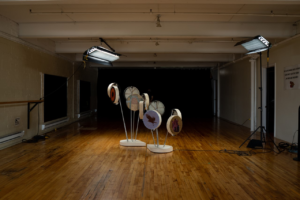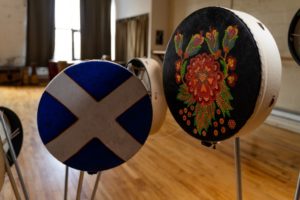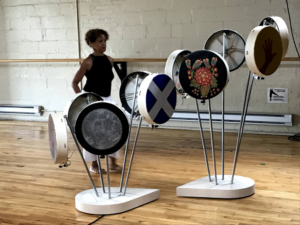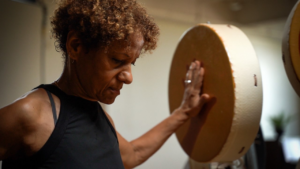Forthcoming from The University of Toronto Press
The Sensory Studies Manifesto:
Tracking the Sensorial Revolution in the Arts and Human Sciences
David Howes
Concordia University
An intense new focus on the cultural life f the senses has swept over the human sciences in the past few decades. This sensorial revolution wit its roots in the disciplines of history and anthropology has extended to include the disciplines of geography and sociology, and also spilled over into the world of art and design. This Manifesto tracks these change and open up many novel lines of investigation into how human being sense and make sense of the world, upending the monopoly that the discipline of psychology formerly exercised over the study of the senses and sensation. By foregrounding the agency, interactivity, creativity and wisdom of the senses as modulated by culture, this Manifesto sets the sage for a radical reorientation of social scientific research and artistic experimentation in which no sense is left unturned. It is a book to be savoured.
Excerpts from Chapter 8
Performative Sensory Environments:
Alternative orchestrations of the senses in contemporary intermedia art
Introduction
In this chapter, I begin by reporting some of the teaching techniques used by R. Murray Schafer while he was Composer in Residence at Concordia University during the Fall term of 2005. I will also discuss the end-of-term production he facilitated, entitled The Theatre of the Senses. Schafer and his students’ production may be regarded as a prototype for the widespread experimentation with the creation of “intermedia art” in the contemporary artworld. In these experiments, art is dematerialized in the sense that it comes off the wall, off the pedestal, etc. and instead suffuses the space of the installation with a symphony of sensations by engaging multiple modalities via diverse media, whence its “intermediality.” It may otherwise take the form of a scent, which is totally immaterial, or a performance, where the parts played by actors and audience intertwine dissolving the so-called fourth wall.
Chris Salter, who holds the Concordia University Research Chair in New Media, Technology and the Senses is one of the prime movers of the sensorial revolution in the creative arts. In section II, I present a sensory ethnography of my experience working with Salter and others, with a specific focus on the design strategies they deploy – namely, sensory restriction, multisensory integration, and sensory decolonization – to create a form of intermedia art called “performative sensory environment” (Howes and Salter 2015, 2019; Salter 2015). The performative sensory environment is like a museum display, only instead of presenting objects it elicits and mixes up the senses, and audience members are transformed from passive spectators into active participants in the co-production of “experiences”. In some countries, these sorts of creative endeavour go under the name of “arts-based research,” while in others, most notably Canada, they are framed as exercises in “research-creation.”1 Research-creation involves uniting artistic expression, scholarly investigation and material experimentation to generate new ways of being and knowing. As such these performance/installation artworks occupy a space “between art and science” (Born and Barry 2010; Gallison and Jones 2014; Sormani et al 2018) or “between art and anthropology” (Schneider and Wright 2010, 2013; Cox et al 2016) and therefore produce and communicate knowledges in ways that conventional academic or artistic specialties cannot touch. New ways of being and knowing are generated within the performative sensory environment, which the visitor gets to try out. The proof is in the experience.
[…]
Sensory Decolonization: The “Sensory Entanglements” Project
The final design strategy to be discussed here could be called “sensory decolonization.” It is at the heart of the “Sensory Entanglements” project, also directed by Chris Salter. This project is grounded in the collaboration of Indigenous and non-Indigenous artists and scholars from Canada (Cheryl L’Hirondelle, David Garneau, and the present writer) and Australia (Brenda Cross, r e a Saunders, Jennifer Biddle). As Salter writes,
the team is attempting to explore the productive tension in how the ‘newness’ of emerging technologies (despite their colonial origins and structures) might enable an ‘Indigenizing’ of sensorial artistic experiences that disrupts historical boundaries, challenges entrenched borders, creates potential forms of culturally specific empathy, and potentially may de-colonize the representation of otherness (2018: 89)
Cheryl L’Hirondelle is an interdisciplinary artist of mixed Cree/Métis, German/Polish ancestry, and one of the original members of the “Sensory Entanglements” research team. In December 2016, in collaboration with Plains/Woodland Cree elder Joseph Naytowhow, her artistic partner, she staged Yahkâskwan Mîkiwahp (or “light tipi”).6 The materials for this performance piece consisted of bundles of Prairie sage and high-powered handheld flashlights. Participants were invited to convene at an open space near downtown Toronto in the falling dark. There they took up positions in a large circle, clutching their smouldering sage bundles, and were instructed to hold their flashlights up in the air in the form of the poles of a tipi. The ghostly image of a tipi took shape against the backdrop of the Toronto skyline with the CN Tower. The non-Indigenous participants in this smudging ceremony were enveloped in the clouds of smoke and interpellated in an Indigenous architectural form. This created a rupture both in the conventional ordering of the senses and of space in the dominant society, and set the stage for a sharing circle, in which Cheryl engaged the audience by sharing stories, song and Indigenous teachings and language in a bid to connect the participants with the earth and waters, and open their hearts and minds. This performance, then, uses the media of sound, light, smoke and scent as well as proprioception to “fit” the audience for contemplation of a more inclusive society. It implicated them in the pressing work of conciliation between Indigenous and non-Indigenous peoples (Robinson 2016; Garneau 2016).
Another founding member of the “Sensory Entanglements” research team is the Métis scholar, artist and art critic David Garneau, who is an Associate Professor of Visual Art at the University of Regina, Regina, Saskatchewan. With the assistance of Garnet Willis, a technical wizard and student in the Individualized (INDI) Ph.D. program at Concordia, David created an installation entitled “Heart Band” (see Figure 8.2). It is an interactive sound installation that consists of ten hand drums which feature paintings in a Métis beaded style, arranged in a figure-8 pattern that conforms to the infinity symbol of the Métis flag. While this installation displays Métis culture, it is also “flagrantly intercultural” (Biddle 2016) due to the fact that drums are common to many musical traditions and that, in the instant case, their skins are of plastic (rather than hide) and electrified. As Garneau declares in his artist statement, this may be taken to suggest that “beneath this [Métis surface] is a bond among peoples at the level of bodies, heart, music, relations with each other and with special things.”
Heart Band was to be shown at a conference at Concordia University entitled “Uncommon Senses III: The Future of the Senses” and at the “Why Sentience?” conference sponsored by the International Symposium on the Electronic Arts (ISEA). Both conferences were scheduled to take place in Montreal in May 2020. The onslaught of the COVID-19 pandemic in March 2020 resulted in both conferences having to be postponed, ISEA2020 until October 2020, and “Uncommon Senses III” until May 2021. The ISEA2020 organizers also elected to migrate their conference online. Virtualizing the event was the only option, given the ongoing restrictions on in-person gatherings. The artists were accordingly asked to make 3 minute videos of their works.
This request could have sounded the death knell for the aesthetic of Heart Band, since an interactive installation depends on the active corporeal presence of an audience for its completion. But it did not. Ingeniously, David saw the virtualization of his installation as an opportunity rather than an obstacle: he resolved to invite a renowned African dancer, Zab Maboungou, who lives in Montreal, to “dance the drums” and film her performance. I was fortunate to be able to attend the shoot at Zab’s dance academy, the Cercle d’Expression Artistique Nyata Nyata, on “the Main” – that is, St. Lawrence Boulevard – in August 2021.
Before describing Zab’s performance, let me say a few words about the objects and soundscape of the installation. David’s original plan was to commission handmade drums from Métis elders in his home province, but he decided against this plan (see Garneau 2016 for an account of some of the considerations that weighed on him in making this decision). The instruments had the appearance of Métis drums – their faces painted with colourful designs in the Métis beaded-style by David (see Figure 8.3), however, their skins were actually made of plastic and their innards were wired with sensors to detect the ambient movements of the intended audience. The sensors in turn triggered soundclips of heartbeats –David’s own heartbeats, in fact. The clips were pre-recorded by Garnett Willis, using an ingenious device. First, Garnett recorded David’s resting heartbeat (63 bpm) Then, David performed a series of calisthenics exercises, including jumping jacks and burpees (74 bpm). Finally, David ran up five flights of stairs and back (hitting 96 bpm). The various tracks were then looped to form sequences, and which sequence sounded, as well as the transition between them, would be determined by the closeness/distance of the members of the audience as they milled about, as well as the cadence at which they moved.
Two things stand out about how the drums were wired for sound. First, unlike conventional musical instruments, which only produce sound when the musician strikes them, or blows through them, or draws a bow across their strings, the drums are contact-less, rather like the theremin. Second, the drums could be seen as sentient beings: they were designed to sense movements and produce sounds all on their own. In other words, they appeared to be animated. This allusion to the so-called animistic worldviews of Indigenous peoples was deliberate, but it was not the case that the drums were “alive” or attributed “agency” by their human maker, as in the conventional anthropological account of animism (see Matthews and Roulette 2018 for a critique of this account). The drums were not “animate things,” but rather embodiments of a “relational ontology.” The latter view eschews essentialism and objectification at once:
instead of seeing all entities as having a preexisting essence, … [it] asserts that entities only emerge when they are in relation with other entities … This means [apprehending or] studying persons and things not in terms of who or what they are (i.e. their essence), but what they do in terms of their capacity to act and affect (Moas and Huybregts 2020: 37)





